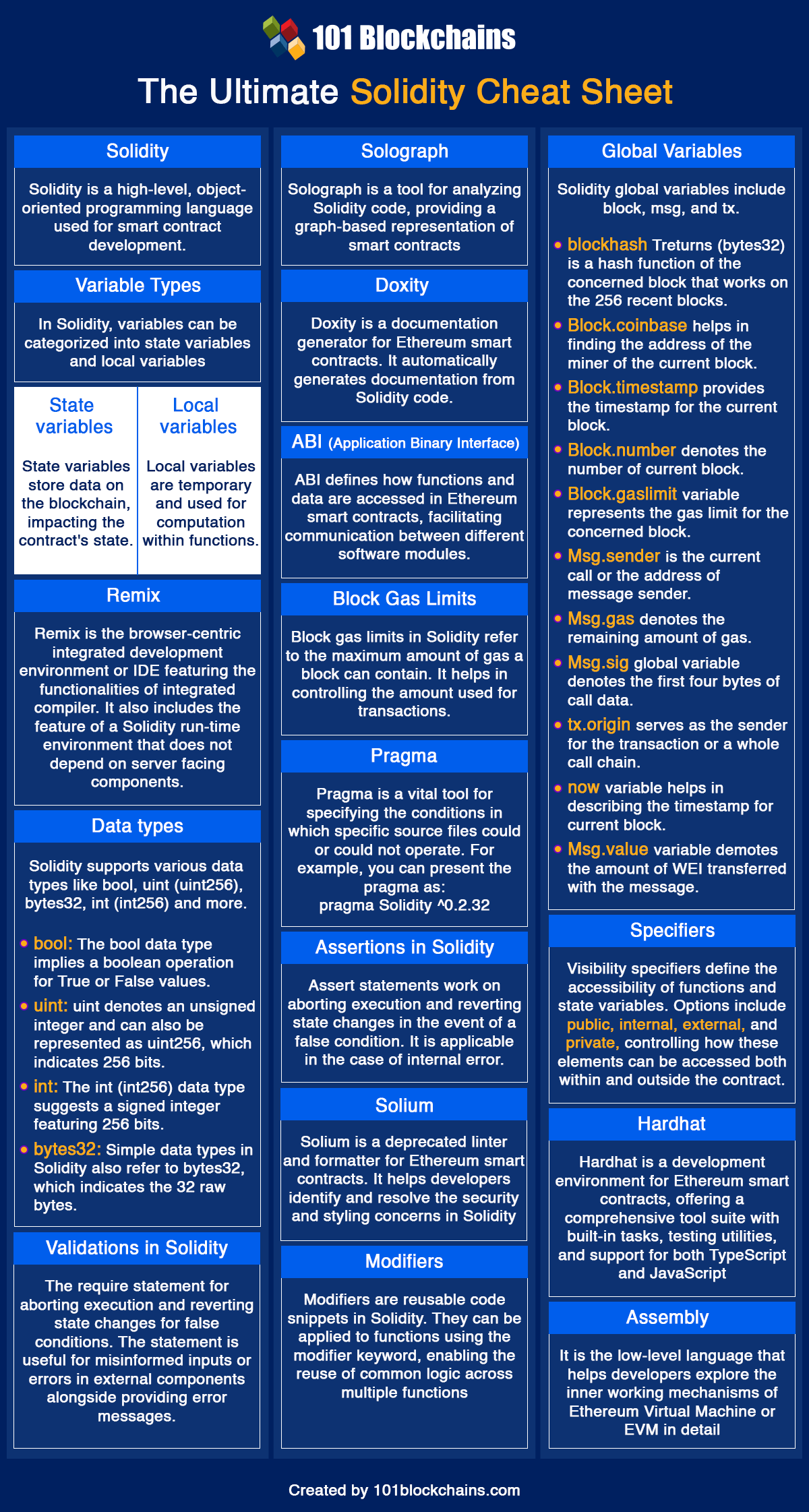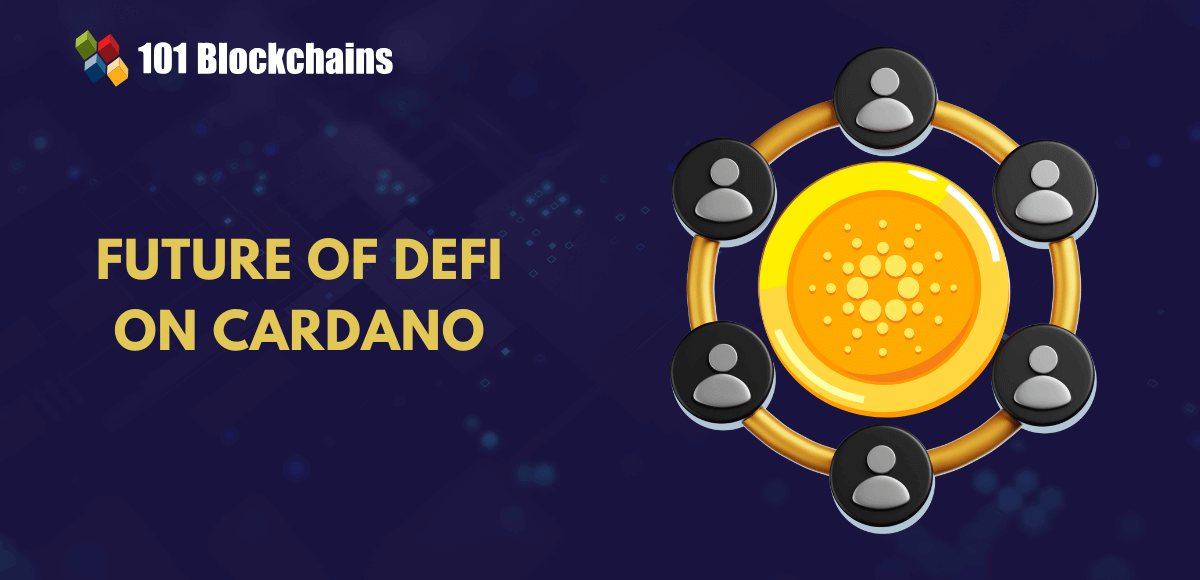Learn how blockchain truly works, master key definitions, and uncover what makes smart contracts so "smart." Dive into the fundamentals, gain valuable insights, and start your blockchain journey today!

- Solidity & Smart Contracts
James Howell
- on June 20, 2023
The Ultimate Solidity Cheatsheet
Solidity is a popular programming language for smart contract development with promising advantages. It was created by the Ethereum Foundation to create smart contracts to deploy on the Ethereum blockchain. The wide range of advantages in Solidity encourages more people to learn Solidity to pursue a career in smart contract development. You can use professional training courses to learn about the use of automated contracts on blockchain networks.
However, the process of writing smart contract code can be quite challenging for developers who use Solidity for the first time. For example, developers can have difficulty finding the right command for their application logic from the massive list of commands and statements in Solidity. The following post helps you learn about some of the important commands and statements you would use in Solidity with solidity cheat sheet tutorial.
Are you aspiring to learn the fundamentals of the Ethereum Virtual Machine and smart contracts’ upgradability? Enroll now in the Advanced Solidity Development Course.
Why Do You Need Solidity Cheatsheet?
The most important question you would ask before using a Solidity cheat sheet would revolve around the reasons for the same. You can use the cheat sheet as a reference document for learning about keywords, syntax, variables, and code basics. The cheat sheet can help you in starting Solidity development projects without concerns about missing important topics.
For example, you can remember the important concepts and functions in Solidity alongside the best practices to create smart contracts for Ethereum blockchain. The reasons to use Solidity cheatsheet is the necessity of cheatsheet for newcomers who want to learn Solidity through practice. You can use it as a reference and build smart contract codes that can serve practical use cases.
Want to get an in-depth understanding of Solidity concepts? Enroll now in Solidity Fundamentals Course
What Can You Find in a Solidity Cheatsheet?
A Solidity cheat sheet would offer valuable advantages to learners with the help of references. It can also support blockchain development professionals in improving their quality of work through immediate access to verified information. You can find out details about the structure of smart contracts, variable types, and precedence of operators, functions, and gas optimization measures in the Solidity Cheatsheet. Here are the important additions to a Solidity cheatsheet that can help you learn the best practices for developing smart contracts.

<pre>Please include attribution to 101blockchains.com with this graphic. <a href='https://101blockchains.com/blockchain-infographics/'> <img src='https://101blockchains.com/wp-content/uploads/2023/06/solidity-cheat-sheet-1.png' alt='solidity cheat sheet='0' /> </a> </pre>
Smart Contract Structure
One of the first elements in defining the use of Solidity for smart contract programming refers to the smart contract structure. The first thing in Solidity documentation would refer to the license identifier and specification for imports. The “SPDX-License-Identifier: MIT” offers the license identifier. You should also include pragma in the code, which specifies the version of Solidity. Contract works as a combination of data and functions stored on a specific address in a blockchain network.
Curious to understand the complete smart contract development lifecycle? Enroll now in the Smart Contracts Development Course!
Variable Types
The outline of different types of variables is also an important part of the cheatsheet for Solidity programming. You can find answers to “What is the easiest way to learn Solidity?” by reflecting on the description of variable types in this cheat sheet. Developers can declare state variables as public or private.
Public declaration type can help in generating a public view function. It is also important to remember that developers can declare variable types as immutable or constant. Immutable variables could be assigned only to the constructor. On the other hand, assigning constant variables is only possible at the time of declaration.
Simple Data Types
The review of developer cheat sheets in Solidity also brings you across simple data types. Simple data types in Solidity include bool, uint (uint256), bytes32, and int (int256). The bool data type implies a boolean operation for True or False values. On the other hand, uint denotes an unsigned integer and can also be represented as uint256, which indicates 256 bits. The int (int256) data type suggests a signed integer featuring 256 bits. Simple data types in Solidity also refer to bytes32, which indicates the 32 raw bytes.
Build your identity as a certified blockchain expert with 101 Blockchains’ Blockchain Certifications designed to provide enhanced career prospects.
Remix
Remix is the browser-centric integrated development environment or IDE featuring the functionalities of integrated compiler. It also includes the feature of a Solidity run-time environment that does not depend on server-facing components.
Solium
The role of Solium in a Solidity cheatsheet how it works in the role of a linter for identifying and resolving the security and styling concerns in Solidity.
Solograph
Solograph is a promising tool for Solidity developers that helps in visualization of the Solidity control flow, alongside highlighting security pitfalls.
Start your blockchain journey Now with the Blockchains Fundamentals Free Course!
Doxity
Doxity is a popular tool you would come across in a Solidity cheat sheet, as it serves an important role for developers. Solidity uses Doxity in the form of a documentation generator.
ABI
ABI, or Application Binary Interface, is the data encoding scheme that can facilitate interactions with smart contracts.
Block Gas Limit
The Block Gas Limit is also an important term for Solidity developers as it helps in controlling the amount used for transactions.
Master the art of Smart Contract development with Solidity to create innovative web3 applications for diverse use cases as a Solidity expert with Solidity Skill Path
Global Variables
The search for answers to “What is the easiest way to learn Solidity?” would lead learners to cheat sheets. You can use Solidity cheat sheets to familiarize yourself with the unique variables which you can find in the boundaries of global namespace.
The global variables you can come across in Ethereum include the following,
- blockhash (uint numberOfBlock) returns (bytes32) is a hash function of the concerned block that works on the 256 recent blocks. At the same time, it also excludes the current block.
- Block.coinbase (address) helps in finding the address of the miner of the current block.
- Block.timestamp (uint) provides the timestamp for the current block.
- Block.number (uint) denotes the number of current block.
- Block.gaslimit (uint) variable represents the gas limit for the concerned block.
- Msg.sender (address) is the current call or the address of message sender.
- Msg.gas (uint) denotes the remaining amount of gas.
- Msg.sig (bytes4) global variable denotes the first four bytes of call data.
- tx.origin (address) serves as the sender for the transaction or a whole call chain.
- now (uint) variable helps in describing the timestamp for current block.
- Msg.value (uint) variable demotes the amount of WEI transferred with the message.
Pragma
Pragma is another crucial highlight in Solidity documentation for developers. It is a vital tool for specifying the conditions in which specific source files could or could not operate. For example, you can present the pragma as
pragma Solidity ^0.2.32
Importing Files
The cheatsheet for Solidity would also include the syntax for importing files such as the following.
import "filename"; import * as symbolName from "filename"; or import "filename" as symbolName; import {symbol1 as alias, symbol2} from "filename"; Members in bytes and string
Developers can concatenate different arguments in one byte array by using the following function,
Bytes.concat(…) returns (bytes memory)
Similarly, developers can concatenate different arguments into one string array by using the following function,
String.concat(…) returns (string memory)
Want to learn the basic and advanced concepts of Ethereum? Enroll in our Ethereum Development Fundamentals Course right away!
Members of address
The Solidity developer cheat sheets can also help you identify the important members of the ‘address’ function in Solidity programming. Here are some of the notable pointers you would find as members of ‘address’ function.
You can find the balance in the address in terms of Wei with the help of <address>.balance (uint256).
The <address>.code (bytes memory) also showcases the code at the address and could be empty in some cases.
The outline of Solidity cheatsheet for beginners would also point to finding the code hash of the address with <address>.codehash (bytes32).
Developers can utilize <address payable>.transfer (uint256 amount) for sending a particular amount in Wei to the address and throwing the transaction upon failure.
On the other hand, <address payable>.send(uint256 amount) returns (bool) can help in sending a specific amount of Wei to Address. Upon failure, the statement returns false.
Curious to know how to build your expertise in Ethereum technology? Check the detailed guide Now on How To Advance Your Ethereum Skills?
Validations and Assertions in Solidity
The answers to “What is the easiest way to learn Solidity?” would revolve around the use of assertions and validations. Solidity programming language uses validations and assertions for defining important functionalities in smart contracts. Here are the crucial validations and assertions for Solidity developers.
The “assert (bool condition)” statement works on aborting execution and reverting state changes in the event of a false condition. It is applicable in the case of internal error.
Developers can use the “require (bool condition)” statement for aborting execution and reverting state changes for false conditions. The statement is useful for misinformed inputs or errors in external components alongside providing error messages.
You can also refer to a solidity cheat sheet for the revert(), which helps in aborting the execution of contracts and reverts the state changes.
The “revert (string memory message)” helps in aborting execution and reverting state changes alongside a string which provides an explanation.
The “require (bool condition, string memory message)” statement also helps in aborting execution and reverting contract changes.
Want to know the real-world examples of smart contracts and understand how you can use it for your business? Check the presentation Now on Examples Of Smart Contracts
Function Modifiers
The outline of important entries in a cheatsheet for Solidity programming would also include function modifiers. You can refer to Solidity documentation for insights into the basic use of the function modifiers. Here is an outline of the common function modifiers you would come across in Solidity.
The ‘pure’ modifier helps in preventing the modification of state of a contract or accessibility of its state.
You can use the ‘view’ modifier to prevent the modification of state.
The ‘payable’ function modifier is useful for functions to receive Ether together through a call.
The developer cheat sheets for Solidity programming would also showcase how the ‘constant’ modifier for state variables can prevent assignments other than initialization. It is important to ensure that the ‘constant’ modifier would not occupy any storage slots.
The ‘virtual’ modifier helps in changing the behavior of a function or a modifier in derived contracts.
You should also note the ‘immutable’ modifier for state variables, which ensures only one assignment at the time of construction. It remains constant afterward and is stored in code.
The Solidity cheatsheet also points at the ‘anonymous’ modifier for events which prevents the storage of event signature as a topic.
Most important of all, the ‘override’ modifier indicates that the concerned public state variable, function, or modifier can change the behavior of functions or modifiers in a base contract.
Excited to learn the basic and advanced concepts of ethereum technology? Enroll Now in The Complete Ethereum Technology Course
Visibility Specifiers
The cheatsheet offers multiple points of reference for solidity developers. You can learn Solidity development at a faster pace with easier access to information about different commands and statements. Here are some of the common visibility specifiers for functions in the Solidity programming language.
The ‘public’ visibility specifier with a function indicates external and internal visibility.
Functions with a ‘private’ tag could be visible only in the existing contract.
You can also come across functions with the ‘internal’ tag, which implies internal visibility only.
The ‘external’ tag for functions would suggest that it is visible only for the functions and cannot be called through a message.
Get familiar with the terms related to ethereum with Ethereum Flashcards
Precedence of Operators
The most important highlight in a Solidity cheat sheet would point at the precedence of operators. Here is an outline of the precedence of operators in Solidity.
- New expression, postfix decrement and increment, member access, array subscription, parentheses, and function-like call.
- Unary minus, Unary operations, prefix decrement, and increment, bitwise NOT, and logical NOT.
- Exponentiation.
- Multiplication, division, and modulus
- Addition and subtraction
- Bitwise shift operators
- Bitwise AND
- Bitwise XOR
- Bitwise OR
- Inequality operators
- Equality operators
- Logical AND
- Logical OR
- Ternary operator and assignment operators
- Comma operator
Cryptographic and Mathematical Functions
The details of a Solidity cheatsheet for beginners would revolve around cryptographic and mathematical functions such as the following.
Ripemd160(bytes memory) returns (bytes20) would help in computing the RIPEMD-60 hash of input.
Similarly, the keccak256(bytes memory) returns (bytes32) can compute the Keccak-256 hash for the input.
The sha256(bytes memory) returns (bytes32) statement helps in computing the SHA-256 hash of input.
Are you planning to become a certified professional with accredited certifications? It’s time to level up your career with 101 Blockchains CPD accredited certification programs.
Conclusion
The outline of important additions in the cheatsheet for Solidity programming offers a brief impression of how you can master Solidity. You can learn Solidity and its underlying concepts by using professional training courses. However, the cheatsheet can work as a reference guide for choosing the important statements and syntax for Solidity code. Most of the responses for “What is the easiest way to learn Solidity?” would point to using a cheat sheet.
It offers information about the tools you need for creating smart contracts and tells you how to use them. In addition, it can help you start using Solidity in practical use cases rather than cramming up the theoretical concepts. Solidity cheat sheets are updated along with the new versions of Solidity and include specialized additions. Learn more about smart contract development and Solidity fundamentals in detail right now.





